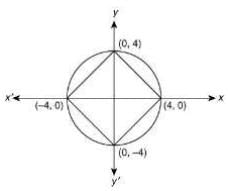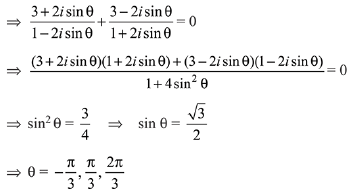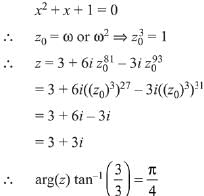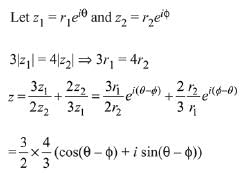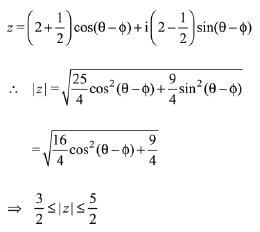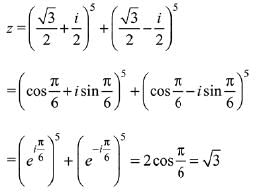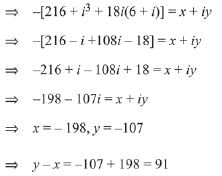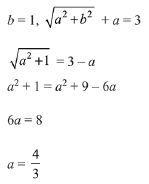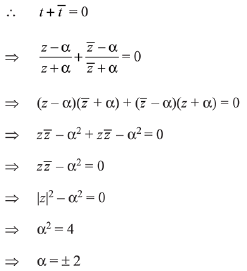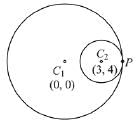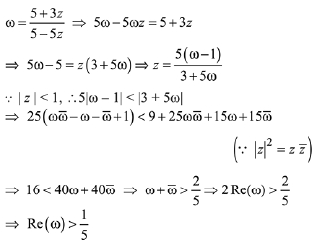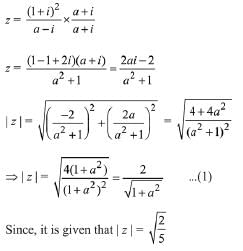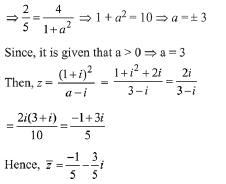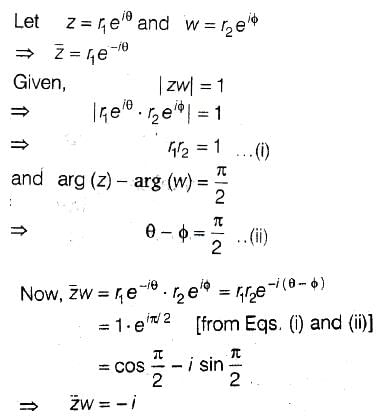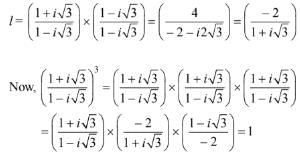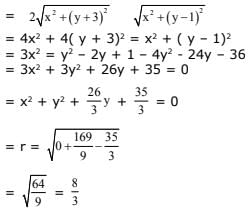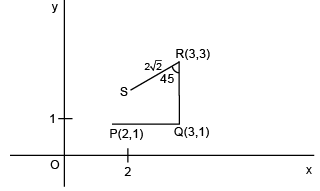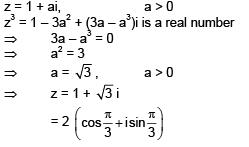Q.1. If  where z = x + iy, then the point (x, y) lies on a (2020)
where z = x + iy, then the point (x, y) lies on a (2020)
(a) Circle whose centre is at 
(b) Straight line whose slope is -2/3.
(c) Straight line whose slope is 3/2.
(d) Circle whose diameter is √5/2.
Ans. d
We have...(1)
Therefore,
Centerand radius
Hence, the diameter of circle is √5/2.
Q.2. If  is a real number, then an argument of sinθ + i cosθ is (2020)
is a real number, then an argument of sinθ + i cosθ is (2020)
(a) π - tan-1(4/3)
(b) π - tan-1(3/4)
(c) - tan-1(3/4)
(d) - tan-1(4/3)
Ans. a
We have
Given that the number is real, then
4 sinθ + 3 cosθ = 0 ⇒ tan θ = -3/4
Hence, the argument of sinθ + i cosθ is
Q.3. If z be a complex number satisfying |Re(z)| + |Im(z)| = 4, then |z| cannot be (2020)
(a) 
(b) √10
(c) √7
(d) √8
Ans. c
Let the complex number be z = x + iy. So,
|x|+|y| = 4 (1)
Now,
Minimum value of
Maximum value of |z| = 4
So, |z| ∈ (2√2, 4).Hence, the value of |z| cannot be √7.
Q.4. Let  Then the sum of the elements in A is: (2019)
Then the sum of the elements in A is: (2019)
(a) 5π/6
(b) π
(c) 3π/4
(d) 2π/3
Ans. d
Since, z is purely imaginary, then
Now, the sum of elements in A =
Q.5. Let z0 be a root of the quadratic equation, then arg z is equal (2019)
then arg z is equal (2019)
(a) π/4
(b) π/6
(c) π/3
(d) 0
Ans. a
∵ z0 is a root of quadratic equation
Q.6. Let z1 and z2 be any two non-zero complex numbers such that  ,then: (2019)
,then: (2019)
(a) Re(z) = 0
(b) 
(c) 
(d) Im(z) = 0
Ans. Bonus
Q.7. Let  If R(z) and I(z) respectively denote the real and imaginary parts of z, then: (2019)
If R(z) and I(z) respectively denote the real and imaginary parts of z, then: (2019)
(a) I(z) = 0
(b) R(z) > 0 and I(z) > 0
(c) R(z) < 0 and I(z) > 0
(d) R(z) = -(3)
Ans. a
Q.8. Let  where x and y are real numbers then y - x equals: (2019)
where x and y are real numbers then y - x equals: (2019)
(a) 91
(b) -85
(c) 85
(d) -91
Ans. a
Q.9. Let z be a complex number such that |z| + z = 3 + i 
Then |z| is equal to: (2019)
(a)
(b) 5/3
(c)
(d) 5/4
Ans. b
Since, |z| + z = 3 + i
Let z = a + ib, then
Compare real and imaginary coefficients on both sides
Then,
Q.10.  is a purely imaginary number and |z| = 2, then a value of α is: (2019)
is a purely imaginary number and |z| = 2, then a value of α is: (2019)
(a) 2
(b) 1
(c) 1/2
(d) 
Ans. a
∵ t is purely imaginary number.
Q.11. Let z1 and z2 be two complex numbers satisfying |z1| = 9 and |z2- 3 - 4i|=4. Then the minimum value of |z1 -z2| is: (2019)
(a) 0
(b) √2
(c) 1
(d) 2
Ans. a
|Z1| = 9, |z2 - 3 - 4i| = 4
z1 lies on a circle with centre C1(0, 0) and radius r1 = 9
z2 lies on a circle with centre C2(3, 4) and radius r2 = 4
So, minimum value of |z1 -z2| is zero at point of contact (i.e. A)
Q.12. If  then (1 + iz + z5 + iz8)9 is equal to:
then (1 + iz + z5 + iz8)9 is equal to:
(a) 0
(b) 1
(c) (-1 + 2i)9
(d) -1
Ans. d
where ω is imaginary cube root of unity.
Q.13. All the points in the set  lie on a: (2019)
lie on a: (2019)
(a) straight line whose slope is 1.
(b) circle whose radius is 1.
(c) circle whose radius is √2 .
(d) straight line whose slope is -1.
Ans. b
Let z∈S then
Since, z is a complex number and let z = x + iy
Then,(by rationalisation)
Then compare both sides...(1)
...(2)
Now squaring and adding equations (1) and (2)
Q.14. Let z ∈ C be such that |z| < 1. If ω =  then: (2019)
then: (2019)
(a) 5 Re (ω) > 4
(b) 4 Im (ω) > 5
(c) 5 Re (ω) >1
(d) 5 Im (ω) < 1
Ans. c
Q.15. If a > 0 and z =  has magnitude
has magnitude  then
then  is equal to: (2019)
is equal to: (2019)
(a) 
(b) 
(c) 
(d)
Ans. a
Then, from equation (1),
Now, square on both side; we get
Q.16. If z and ω are two complex numbers such that |zω| = 1 and arg(z) - arg(ω) = π/2, then: (2019)
(a) 
(b) 
(c) 
(d) 
Ans. c
Q.17. The equation  represents: (2019)
represents: (2019)
(a) a circle of radius 1/2.
(b) the line through the origin with slope 1.
(c) a circle of radius 1.
(d) the line through the origin with slope -1.
Ans. b
Given equation is, |z - 1| = |z - i|
Hence, locus is straight line with slope 1.
Q.18. Let z ∈ C with Im(z) = 10 and it satisfies  for some natural number n. Then: (2019)
for some natural number n. Then: (2019)
(a) n = 20 and Re(z) = -10
(b) n = 40 and Re(z) = 10
(c) n = 40 and Re(z) = -10
(d) n = 20 and Re(z) = 10
Ans. c
On comparing real and imaginary parts,
Hence, Re(z) = -10
Q.19. If α ,β ∈ c are the distinct roots, of the equation x2 - x + 1 =0 , then α101 + β107 is equal to: (2018)
(a) -1
(b) 0
(c) 1
(d) 2
Ans. c
x2 - x+ 1 = 0
Q.20. The set of all α ∈ R, for which ω = is a purely imaginary number, for all z ∈ C Satifying |z| = 1 and Re z ≠ 1, is: (2018)
is a purely imaginary number, for all z ∈ C Satifying |z| = 1 and Re z ≠ 1, is: (2018)
(a) An empty set
(b) 
(c) equal to R
(d) {0}
Ans. d
As ω is purely imaginary
If Re(z) ≠ 1
then, α = 0
Q.21. The least positive integer n for which  is: (2018)
is: (2018)
(a) 2
(b) 5
(c) 6
(d) 3
Ans. d
Also,
∴ Least positive integer n is 3.
Q.22. Let z ∈ C, the set of complex numbers. Then the equation, 2|z + 3i| – |z – i| = 0 represents a circle with radius (2017)
(a) a cirlce with radius 8/3
(b) an ellipse with length of minor axis 16/9
(c) an ellipse with length of major axis 16/3
(d) a circle with diameter 10/3
Ans. a
Q.23. The equation  represents a part of a circle having radius equal to: (2017)
represents a part of a circle having radius equal to: (2017)
(a) 1
(b) 2
(c) 3/4
(d) 1/2
Ans. c
Let = x + y
Q.24. A value of θ for which  is purely imaginary, is: (2016)
is purely imaginary, is: (2016)
(a) π/3
(b) π/6
(c) sin-1
(d) sin-1
Ans. d
To be purely imaginary if
Q.25. The point represented by 2 + i in the Argand plane moves 1 unit eastwards, then 2 units northwards and finally from there 2√2 units in the south- westwards direction. Then its new position in the Argand plane is at the point represented by: (2016)
(a) 2 + 2i
(b) – 2 – 2i
(c) 1 + i
(d) – 1 – i
Ans. c
Let P(2 + i)
By rotation theorem
Q.26. Let z = 1 + ai be a complex number, a > 0 such that z3 is a real number. Then the sum 1 + z + z2 +....+ z11 is equal to (2016)
(a) -1250 √3 i
(b) 1250 √3 i
(c) -1365 √3 i
(d) 1365 √3 i
Ans. c








